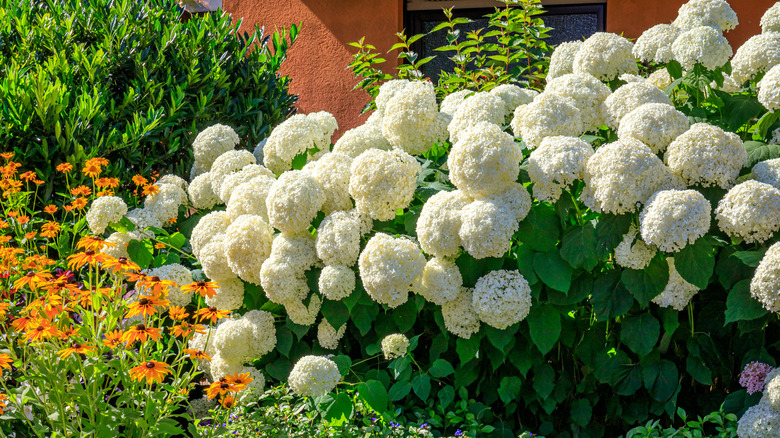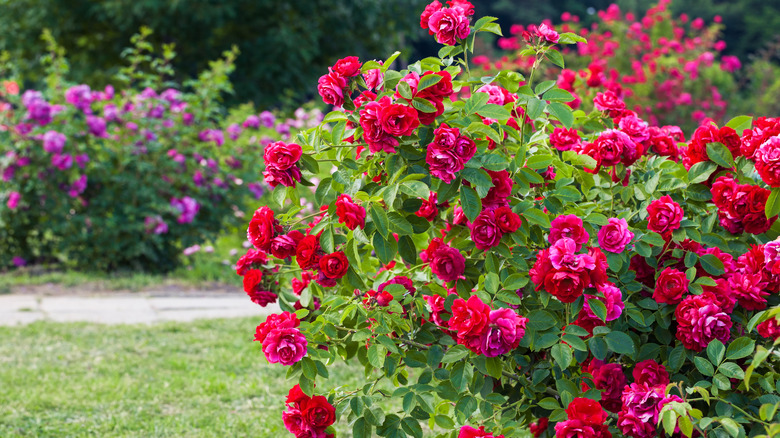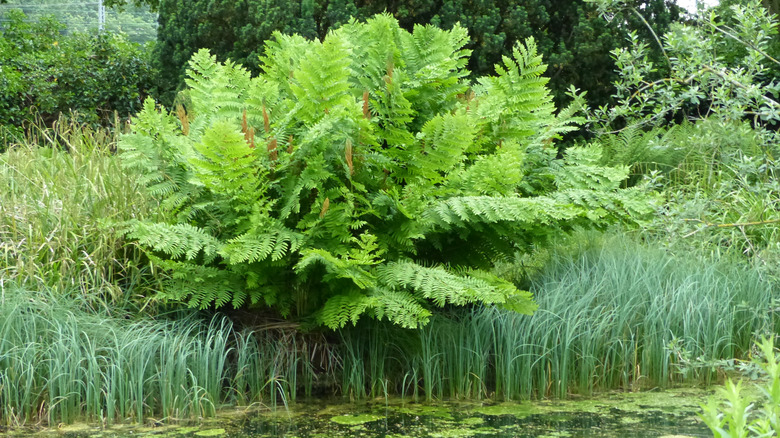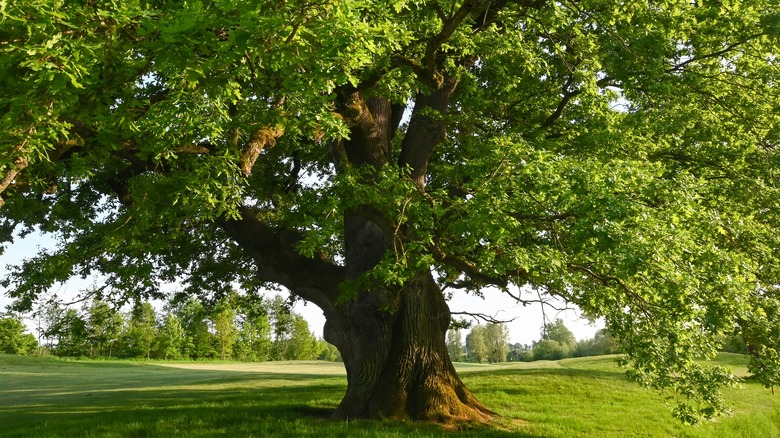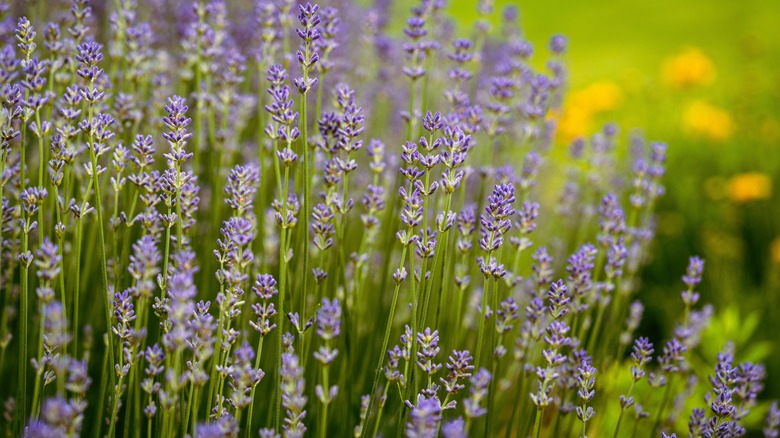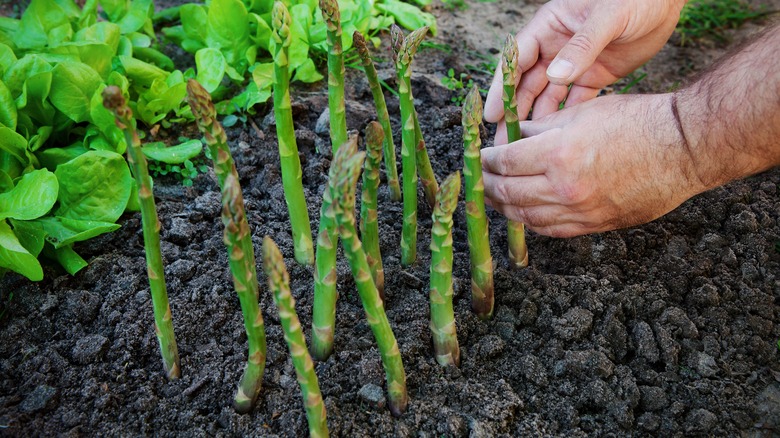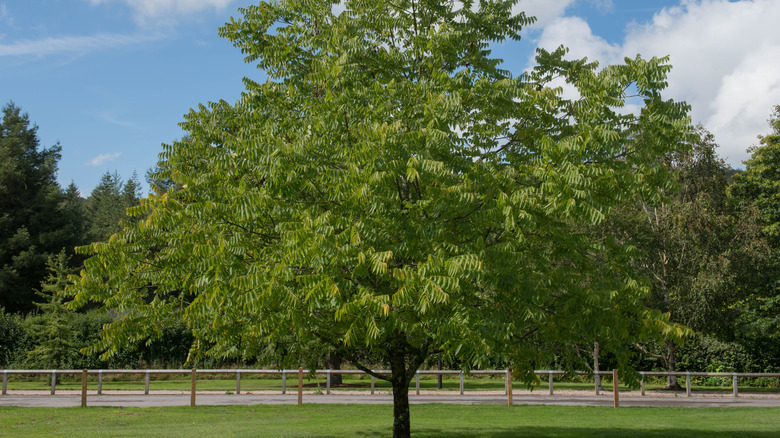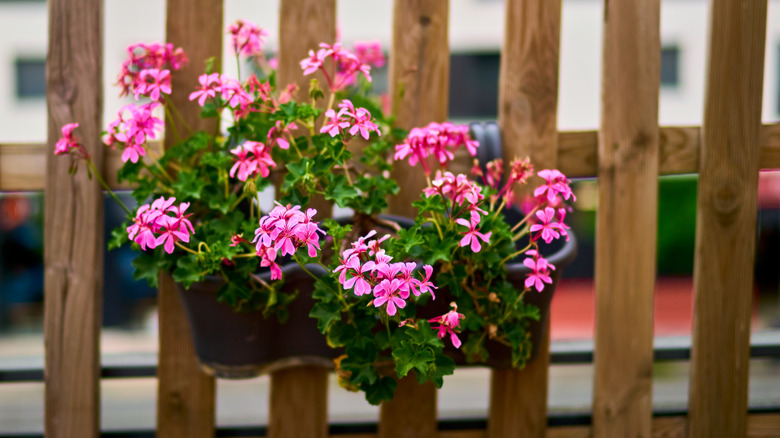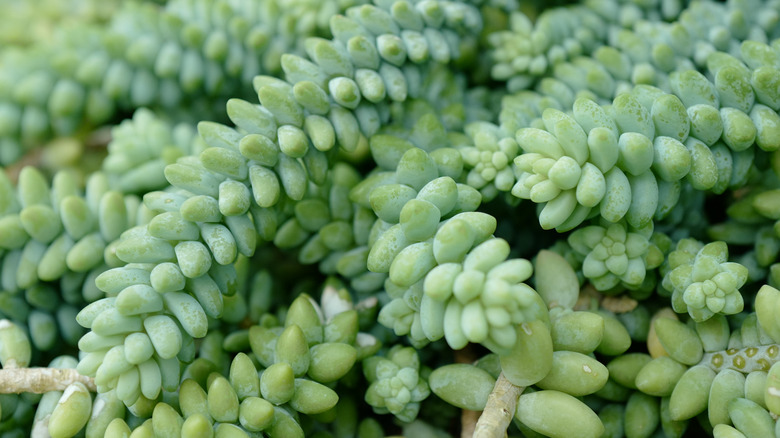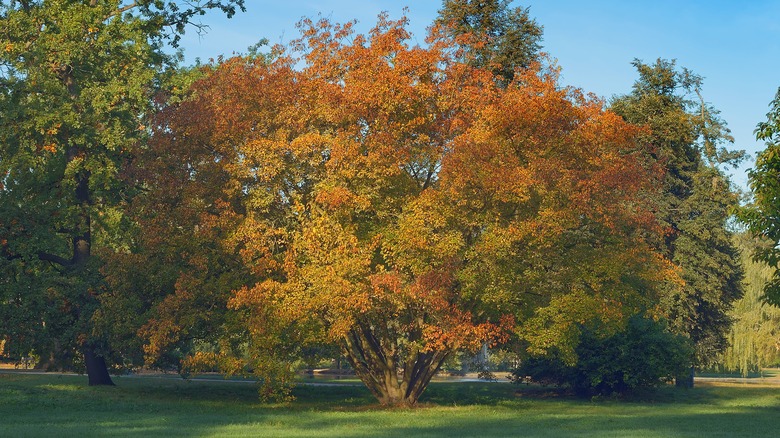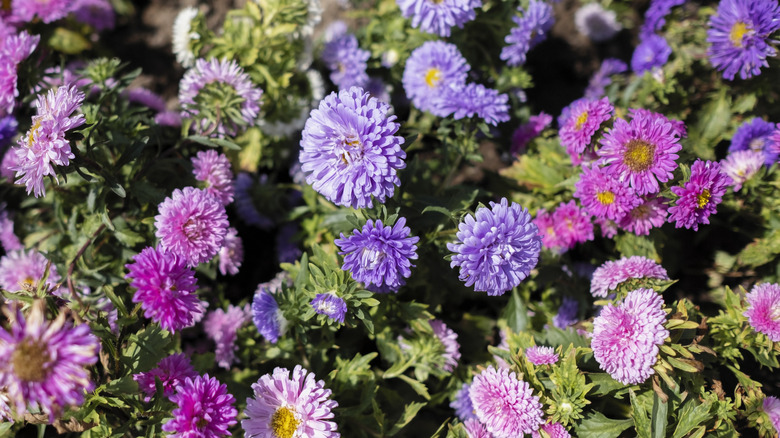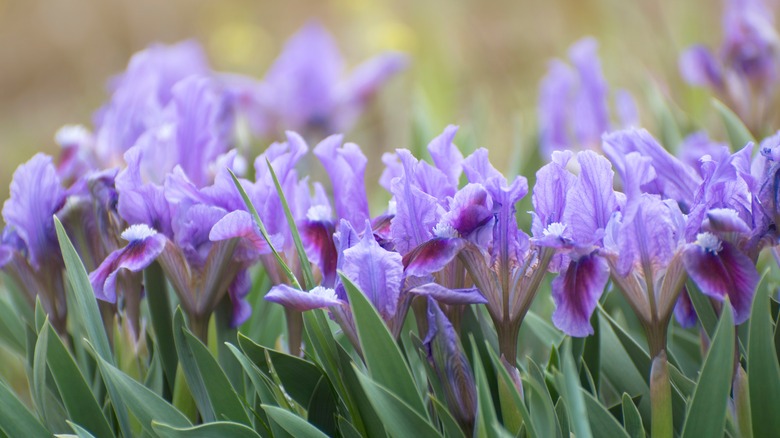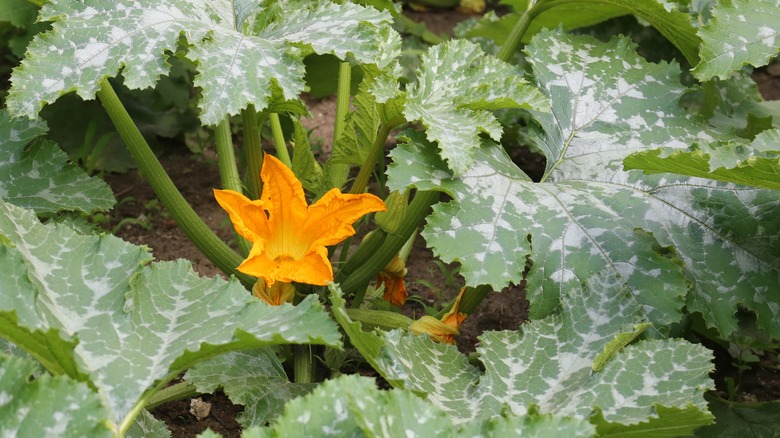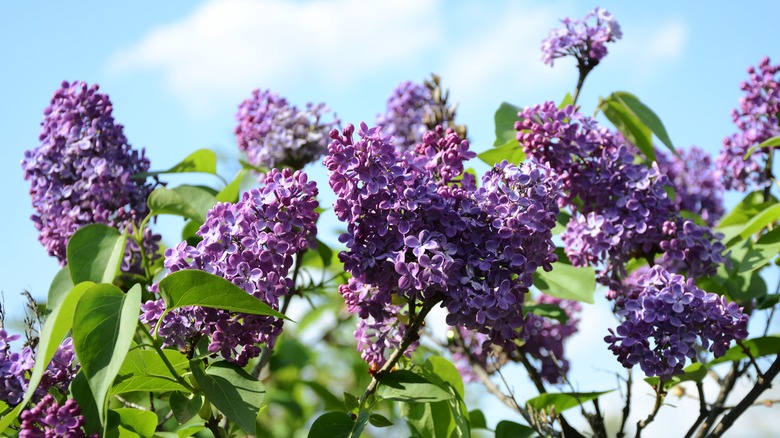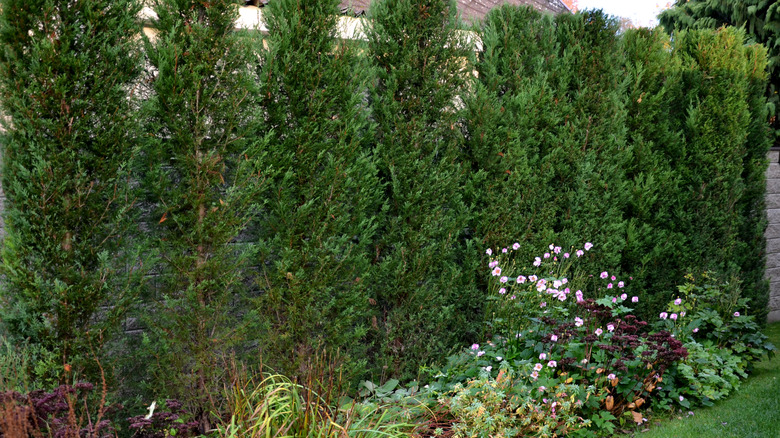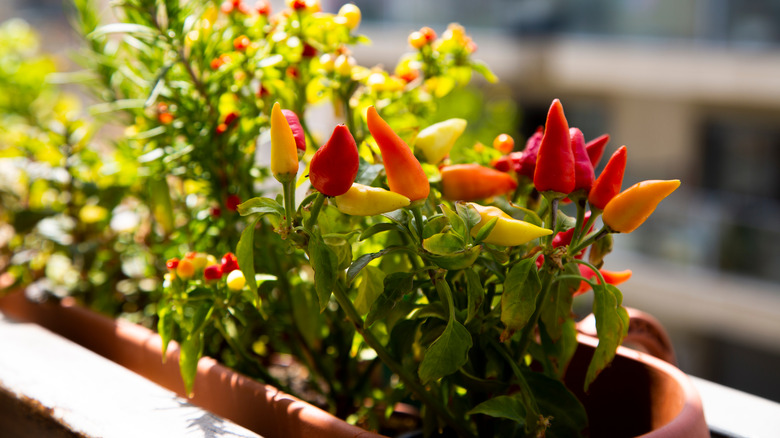Plants That You Won't Want Too Close To Your Hydrangeas
Hydrangeas are well-known flowering bushes that are fairly simple to grow. Likely, you've seen them blooming in front yards as foundation plants or in another partially shady landscape. If you've recently decided to decorate your lawn with hydrangea bushes, you'll want to pair them with the best flowers and foliage-filled plants that will support their growth, not inhibit it. Thankfully, hydrangeas have more companion plants than those that threaten their well-being, so as long as you know what to avoid, it should be easy to grow these prolific bloomers without a hitch.
The genus holds about 75 distinct species that all have similar care needs. The most popular options include bigleaf hydrangeas (H. macrophylla), smooth hydrangeas (H. arborescens), oakleaf hydrangeas (H. quercifolia), and panicled hydrangeas (H. paniculata). Each of these needs at least some shade in the afternoon, plenty of moisture, lots of space to grow, and organically rich soil that's well-draining. Any flower, shrub, fern, grass, or tree that opposes these needs or takes away from them is usually a bad pairing. In this collection, browse through our short list of species that you should be wary of as you plan for these gorgeous bushes.
1. Roses
Roses (Rosa spp.) are sometimes recommended for growing with hydrangeas, but they're usually a bad pair because roses are sun-loving and hydrangeas are shade-loving. If you want to make it work, you could choose a variety of shade-tolerant roses and sun-tolerant hydrangeas. As a general rule, however, you should keep the two flower bushes in separate parts of your landscape where both of their needs can be met in full.
Bloom Season: Spring to fall
USDA Growing Zone: 7 to 11
Growing Conditions: Full sun
Soil Type: Well-draining
Size: 4 feet tall and wide
2. Royal fern
Royal ferns (Osmunda regalis) are non-flowering plants that are often grown in rain gardens. With the help of some wet soil near a stream or pond, the ferns grow quickly, sometimes up to 6 feet tall if they are plenty moist. Because of their love for poorly draining soil, however, it is difficult to grow them next to hydrangea species.
USDA Growing Zone: 3 to 9
Growing Conditions: Partial shade to full shade
Soil Type: Moist, rich, and acidic
Size: 2 to 3 feet tall and wide
3. Oak tree
Oak trees (Quercus robur), as well as several other tall-growing trees, are best kept away from hydrangea bushes. Their large habit, dense canopy of leaves, and thick roots make growing close by too difficult. Hydrangeas planted close to the tree's trunk will have the worst shot at healthy growth while their roots are tightly bound and they are given little space to grow.
Bloom Season: Spring
USDA Growing Zone: 5 to 8
Growing Conditions: Full sun
Soil Type: Moist, well-draining, and loamy
Size: 40 to 70 feet tall and wide
4. Lavender
Lavender plants (Lavandula angustifolia) are among the worst companion plants for hydrangeas. They enjoy lots of sun, dry conditions, and alkaline soil. Lavender plants might as well be the opposite of hydrangea bushes. Unfortunately, even though they look great together, you'll want to keep these two far apart to see the best growth in each.
Bloom Season: Summer
USDA Growing Zone: 5 to 8
Growing Conditions: Full sun
Soil Type: Low fertility, alkaline, and well-draining
Size: 3 feet tall and 4 feet wide
5. Asparagus
Asparagus (Asparagus officinalis) isn't commonly grown with hydrangeas, but if you are one to create odd pairs, make sure you skip this one. Both plants are picky about their soil but in opposite ways. Asparagus grows best in alkaline soil with a Ph above 6, while hydrangeas prefer acidic soil with a Ph of 6.2 or lower.
Bloom Season: Insignificant flowers in spring and summer
USDA Growing Zone: 3 to 10
Growing Conditions: Full sun
Soil Type: Organically rich and well-draining
Size: 3 to 4 feet tall and 1 to 2 feet wide
6. Black walnut tree
Black walnut trees (Juglans nigra) are notoriously problematic for growing next to hydrangeas. The tree in the Juglans genus produces juglone, which is a toxic substance that slows nearby plants' growth. Not only does juglone affect hydrangea species, but also tomatoes, peas, chestnut trees, azaleas, and lilacs, to name a few.
Bloom Season: Late spring to summer
USDA Growing Zone: 4 to 9
Growing Conditions: Full sun
Soil Type: Moist, rich, and well-draining
Size: 50 to 75 feet tall and wide
7. Tender geraniums
As a general rule, it's best to avoid planting Mediterranean plants next to hydrangea bushes. One example is the tender geranium plant (Pelargonium spp.), which is a sun-loving flower that easily withstands high temperatures and prolonged drought. If you want to enjoy geraniums' gorgeous scented blossoms that bloom all summer long, make sure they are planted in a dry area that receives plenty of sun.
Bloom Season: Late spring and summer
USDA Growing Zone: 9 to 12
Growing Conditions: Full sun
Soil Type: Fertile and well-draining
Size: 1 to 2 feet tall and wide
8. Sedum burrito
Sedum burrito (Sedum morganianum), a popular landscaping plant, is well-liked for its ability to grow in extremely dry, hot, and sunny locations. Like tender geraniums, the succulent plant cannot grow properly in shaded and moist soil. Sedum burrito looks best when it's grown in a hanging container or in a sunny part of your lawn where its trailing stems act as ground cover.
Bloom Season: Spring
USDA Growing Zone: 10 to 11
Growing Conditions: Full sun or partial shade
Soil Type: Well-drained
Size: 3-foot-long stems
9. Amur maple tree
The amur maple tree (Acer ginnala) is grown in colder climates where it is tolerant of cool winds and poor or dry soil. You would think that it would be a good companion for hydrangeas since they can thrive under tall leafy canopies. Yet, the two really don't get along as they compete for root space. Normally, maple tree roots are too large and aggressive to pair the prolific plants together.
Bloom Season: Spring
USDA Growing Zone: 3 to 8
Growing Conditions: Full sun to partial shade
Soil Type: Well-draining
Size: 15 to 20 feet tall and wide
10. China aster
China asters (Callistephus chinensis), also called annual asters, are multicolored flowers that bloom later in the season for a burst of color. Grown next to hydrangea bushes, these annual flowers may not receive the sunlight and space that they need to bloom properly. China asters are best planted in a garden plot where air circulation is good and the soil is consistently moist.
Bloom Season: Summer to fall
USDA Growing Zone: 2 to 11
Growing Conditions: Full sun
Soil Type: Evenly moist, fertile, and well-draining
Size: 20 to 40 inches tall and 4 to 20 inches wide
11. Dwarf iris
Dwarf irises (Iris pumila) are known for their tiny habit and bright lavender to true blue blooms that appear in the early spring. Often, they are planted in large groups where they bloom year after year, but people will still sometimes plant them beneath large trees and bushes. The latter is not recommended. Though these are tough flowers, they do not appreciate full shade or too much water.
Bloom Season: Spring and summer
USDA Growing Zone: 3 to 10
Growing Conditions: Sun to partial shade
Soil Type: Well-draining
Size: 12 to 18 inches tall
12. Squash
Squash varieties (Cucurbita pepo), as well as zucchini and ornamental gourds, are all a part of the same genus and species. Unfortunately, none of them should be grown with hydrangeas. The vegetable plant is a heavy feeder that will quickly steal nutrients away from your bushes. They also have very different needs. Squash plant cultivars usually need mulching, full sun, and lots of space to grow.
Bloom Season: Summer
USDA Growing Zone: 3 to 11
Growing Conditions: Full sun
Soil Type: Evenly moist and well-draining
Size: 1 to 3 feet tall and 2 to 25 feet wide
13. Lilac bush
Lilac bushes (Syringa vulgaris) can be pals with hydrangea bushes, but their relationship is fraught. Lilacs, which frequently grow taller than 15 feet high, favor full sun and alkaline soil. Grown in the same area as hydrangeas, the fragrant and purple-blooming bush will struggle to produce flowers and compete for moisture and space, while also suffering if the soil below is too acidic.
Bloom Season: Spring
USDA Growing Zone: 3 to 7
Growing Conditions: Full sun
Soil Type: Acidic and well-draining
Size: 12 to 16 feet tall and 8 to 12 feet wide
14. Leyland cypress
Another tall species, Leyland cypress (Cupressus × leylandii) is grown for its giant habit that makes it a great candidate for use as a hedge or screen. This is also sometimes true for hydrangea bushes, but the two should never be grown up against each other. As they begin to fight for space and nutrients, the cypress hybrid is likely to overtake your hydrangeas.
USDA Growing Zone: 6 to 10
Growing Conditions: Full sun
Soil Type: Moist, rich, and well-draining
Size: 60 to 70 feet tall and 15 to 25 feet wide
15. Peppers
Peppers (Capsicum annuum), like squash, are heavy feeders. They love exposure to bright direct sunlight and little water. All kinds of peppers, including cayenne peppers, chili peppers, and ornamental peppers, can grow happily together in one garden bed, but they shouldn't be planted with hydrangea species. Consider keeping your pepper plants in a container for easy harvest and to make sure they stick to their designated location.
Bloom Season: Summer
USDA Growing Zone: 4 to 11
Growing Conditions: Full sun
Soil Type: Well-draining
Size: 1 to 4 feet tall and 6 to 12 inches wide
